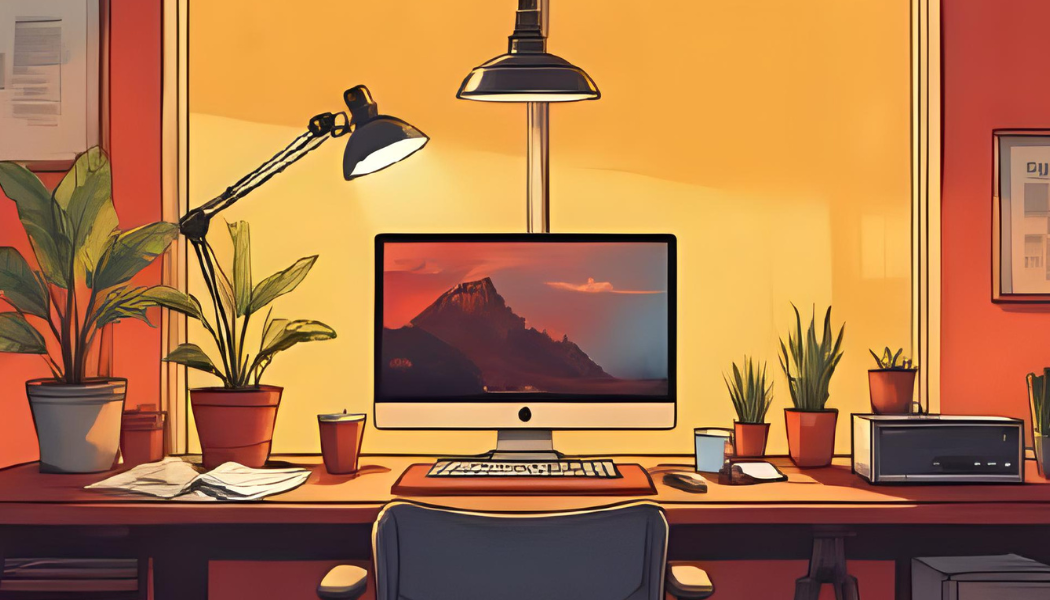
Do these sentences resonate? 👇
- “My back hurts after two hours at my desk.”
- “My laptop is on a shoebox and the glare is blinding.”
- “I want a setup that fits my budget, my style, and my space.”
You’re standing in your room with a coffee, juggling a laptop, a ring light, and three tangled cables. Somehow “working from anywhere” turned into “working on top of everything.”
A good desk setup is not about aesthetics only, it is about energy, focus, and comfort. The goal: build a space that supports our body and our brain, whether we are studying, gaming, creating, or working. Below, we cover the essentials with practical, budget-friendly tips, plus how this looks when you are BIPOC, first-gen, or low-income and dealing with tiny rooms, shared spaces, and tight funds. 🎒

“Caring for myself is not self-indulgence, it is self-preservation.” — Audre Lorde, A Burst of Light
What is “neutral posture” and why should we care?
When our joints line up in a relaxed, neutral position, we reduce strain on muscles and tendons. That means screen top near eye level, elbows close to our sides, wrists straight, and feet supported. Small changes here prevent big aches later.
Quick moves to try:
- Put the monitor directly in front of you, at least an arm’s length away.
- Aim for the top of the screen at or just below eye level.
- Keep shoulders relaxed, lower back supported, and feet flat.
What about eyes and screens? 👀
Digital eyestrain is real, especially with marathon laptop sessions. The American Optometric Association suggests the 20-20-20 rule: every 20 minutes, look 20 feet away for 20 seconds. Pair that with reducing glare and matching screen brightness to the room.
Easy wins:
- Place screens perpendicular to windows to cut glare.
- Nudge brightness so your screen is not a flashlight.
- Blink, drink water, and schedule micro-breaks.
What lighting actually helps? 💡
Good lighting keeps us alert without frying our eyes. Typical office tasks feel comfortable around the low hundreds of lux with task lighting for detail work. If the overhead light is dim or harsh, add a small desk lamp you can aim away from the screen.
Try this:
- Bounce a lamp off a wall for softer light.
- Avoid direct light hitting the display.
What counts as a solid budget setup?
You do not need a Pinterest budget to feel good at your desk. Start with stability and height.
Minimum viable setup:
- A stable surface at elbow height, a chair with back support, and a laptop raised to eye level.
- External keyboard and mouse so wrists stay neutral.
- A box, stack of books, or cheap riser can lift the screen.
What if we use a sit-stand desk?
Switching between sitting and standing during the day can reduce static loading on our body. The key is alternating positions and keeping that same neutral alignment in both modes.
What does Gen Z data say about work and screens?
We build better setups when we know what our days really look like. For many of us in Gen Z, the reality is high screen time and a preference for at least some in-person connection. 📱🏢
Quick snapshot:
- Only 23% of remote-capable Gen Z workers say they want to be fully remote; most prefer hybrid. Connection and learning matter.
- A recent study found 53.8% of Gen Z reported digital eye strain with 6+ hours of daily screen use. That is your sign to raise the screen and take breaks.
- Workplace research shows Gen Z reports longer hours including nights and weekends, and many say their eye health is worsening as a result. Protect those eyes.
What about small rooms, shared spaces, or low budgets? 🧩
Here is where many of us live. If you are BIPOC, first-gen, or low-income, you might be sharing a bedroom, splitting a living room, or helping with family responsibilities. That limits space, time, and money, not your right to a healthy setup.
Real-world strategies:
- Compact gear: folding desk, clamp-on lamp, laptop stand that tucks away.
- Multi-use: a rolling cart for supplies so your workspace packs up fast for shared rooms.
- Secondhand first: thrift stores, local buy-nothing groups, campus forums, refurbished keyboards and monitors.
- Community options: libraries, community centers, and college labs often provide quiet seating, monitors, or study carrels.
- Advocacy: if your employer requires computer work, you can ask about stipends, equipment loans, or reasonable accommodations for ergonomic needs under the ADA.
What if pain or access is a barrier?
Comfort is not a luxury item. If you have a condition that makes standard setups hard, you can request modifications such as an ergonomic chair, footrest, split keyboard, or alternative pointing device. Employers may ask for limited documentation if the need is not obvious, then they should work with you to find a reasonable solution.
What simple checklist keeps us honest? ✅
A one-minute audit helps us reset when life gets chaotic.
- Chair supports lower back, feet supported.
- Screen top at or just below eye level, about an arm’s length away.
- Keyboard and mouse close, wrists straight.
- Glare managed, room lighting comfortable.
- Short break every hour to move and reset.
Before we tweak one more cable or buy one more gadget, let’s zoom out. Take a moment to notice how your current setup actually feels: in your body, in your mood, and in your day.

“Simplicity is about subtracting the obvious and adding the meaningful.” — John Maeda, The Laws of Simplicity
Take a minute to reflect. Here are five quick prompts to help you check in with yourself and choose the next move with intention:
- What do YOU need to feel focused and calm?
- What small change helps YOU most this week?
- How can YOU make setup resets effortless?
- What does comfort cost for YOU, and what is free?
- Who can support YOUr setup goals right now?

“We can begin by doing small things at the local level, like planting community gardens or looking out for our neighbors. That is how change takes place in living systems.” — Grace Lee Boggs
Click on the dropdowns below to see the easy action items:
Do one of these things TODAY 👇
- Raise your screen to eye level and slide the keyboard closer for neutral wrists.
- Add a five-alarm on your phone for micro-breaks and the 20-20-20 rule.
- Pick one budget upgrade to hunt used or borrow: chair, lamp, or keyboard.
Say one (or all) of these affirmations out loud 👇
- "My workspace can be simple, supportive, and mine."
- "I deserve comfort while I learn and earn."
- "Small tweaks today protect future me."
- "I can ask for help and still own my process."
- "My culture, story, and style belong at my desk."
Channel that feeling 👇
Feeling scattered? Clear a 12-inch “landing strip” on the desk, then start.
Feeling tense? Shoulder rolls, neck stretch, then reset your chair height.
Feeling creative? Make a 10-minute playlist, then sprint one task.
Some vibes to close us out
A desk is more than furniture.
It is a small piece of ground where we protect our bodies, grow our ideas, and make moves for our future.
If you are setting up your first real workspace this month, we are cheering for you. Happy Hispanic Heritage Month.
YOU got this. 💭✨
Sources
- "Fully Remote Work Is Least Popular Among Gen Z." Gallup (2025).
- "The demographics of multigenerational households." Pew Research Center (2022).
- "Computer Workstations eTool." OSHA (2024).

Dig into this topic deeper by signing up for our FREE newsletter.
You'll be able to download the reflection worksheet to put all these actions into one page.
Once you're in, come back to this page and download your new go-to resource.




